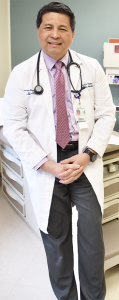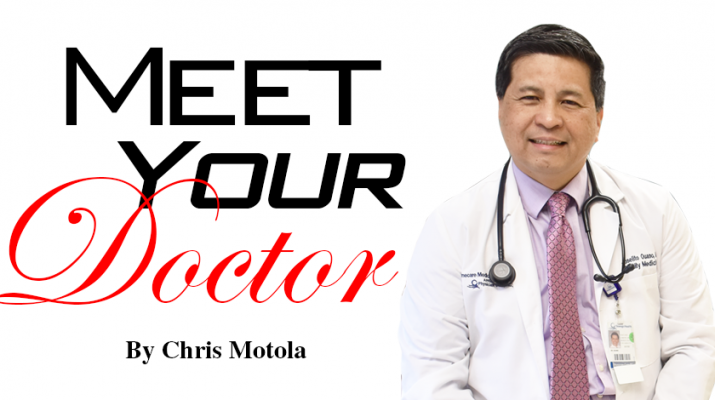New primary care physician in Fulton: “If you talk to them, listen to them and make it a two-way street, you’ll have more success in getting the patient involved in maintaining their health’
By Chris Motola
 Q: Give us an overview of your position and the types of patients you see.
Q: Give us an overview of your position and the types of patients you see.
A: I’m working for Oswego Health. I’m a primary care physician and I’m doing outpatient medicine at their Fulton satellite office called Primecare. It’s one of the offices they’ve established to take care of the community here in Fulton and the surrounding communities.
Q: It seems like recent changes to health care law are looking heavily at primary care as a way of controlling costs. Have you felt that in your practice?
A: I agree with that. Where I used to work, near Allentown, Pa., a lot of larger hospitals established what are called medical homes. It’s basically primary care offices that have been certified by the government to coordinate care for that community for disease management, as far as making for the patients have the proper care from specialists, from social services. So it’s kind of a one-stop shop for the community’s health. We’re creating a situation where patients can go see their primary care physician and start managing all their health care needs, from treating the acute illness, treating chronic illness, educating patients and making sure preventive care is something in the forefront. From I’ve seen, it’s becoming pretty common on the East Coast for primary care to be centralized in guiding care in their community.
Q: You mentioned educating patients. How much of your practice is dedicated to “training” patients, so to speak?
A: It’s always part of the visits. We always talk to them about their health, whether it’s about controlling their weight, avoiding cigarettes, safety issues like seat belts, texting while driving. We try to talk to patients about things that will keep them healthy. It doesn’t take long to discuss most of these things during a visit. If you’re just lecturing them, though, it will go in one ear and out the other. But if you talk to them, listen to them and make it a two-way street, you’ll have more success in getting the patient involved in maintaining their health.
Q: Syracuse is a bit like Allentown, but Fulton is a lot smaller. What made you want to change from practicing in a mid-sized city to a small one?
A: In the Allentown area, I was used to working in large hospital health systems. One of the things I noticed is that when a health system becomes too big, it’s starts to become more business-like. You start feeling like you don’t have as much interaction with your patients. It becomes this fast-paced, get-them-in, get-them-out thing. I knew of this area for quite some time. When I was in high school in Hazelton, Pa., I used to come up to go fishing in Pulaski and passed through Oswego and Fulton on my way to Pulaski. When the opportunity came, I researched the area to see what had changed, and saw that it still had the small community feel, lots of outdoor activities. And it has a health care system where you still have some control over the amount of time you have with your patient without being micromanaged.
Q: Have you noticed much difference in the types of issues that patients present with in Fulton compared to Allentown?
A: Pretty much still seeing the same type of people in Fulton. The only population I’m not seeing much here that I saw there were the Amish.
Q: Is that difficult? Are there certain things you can’t do for them?
A: No. They don’t have insurance, so they’re all cash-paying. They would generally wait until there were health issues that they couldn’t handle. They’re a population that are stoic and you generally won’t see them for annual check-ups. We were usually more of a last resort for them.
Q: What kind of impact would you like to have on the Oswego Health system?
A: Certainly the goal here is to let the community know that we’re here, we’re available and they shouldn’t have to wait long to be seen. The population can have someone locally now to go to. A lot of the local practices were overbooked and having a hard time accepting new patients. So hopefully we can alleviate that congestion and help keep the community as healthy as possible.
Q: Back when A. L .Lee Memorial Hospital was still a hospital, one of the arguments for keeping it intact was that, during the worst of lake effect season, the 10-mile distance between Oswego and Fulton might as well be 80 miles. To what degree are you able to provide comprehensive care to Fultonites who can’t easily make it to Oswego or Syracuse?
A: Our practice is outpatient, so we provide chronic care — diabetes, high-blood pressure, common injuries. We do preventive medicine, education and screenings. We have support of the facility next to us, which does blood work, mammograms, MRIs, so we can get studies done right here. In the office we’re in right now, we’re getting some specialists, so patients can follow-up with a surgeon here if, say, they got their surgery in Oswego. Our hope is to get additional sub-specialists here regularly to save patients some time. We’d like to get as much as we can done here. It’s a nice, modern facility that can serve the majority of the community’s needs. Now, complicated illnesses and major surgeries may still need to be referred to Oswego or Syracuse, but we can still help guide them to where they need to be.
Lifelines
Name: Joselito Ouano, M.D.
Position: Family medicine physician at Primecare
Hometown: Hazelton, Pa.
Education: Cebu Institute of Medicine; The Reading Hospital of Pennsylvania; Pennsylvania State University
Affiliations: Oswego Health
Organizations: American Academy of Family Physicians
Family: Wife (Vivian); son (Justin); daughter (Sydney)
Hobbies: Gardening, hiking, fishing, target shooting, tennis, reading

